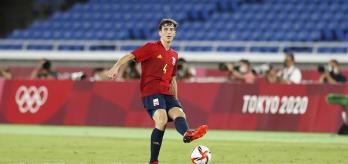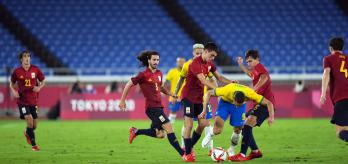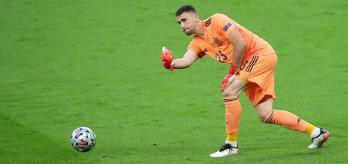Dynamism and unpredictability
The tournament’s most successful teams all possessed a balance across their front threes that served to bring an element of dynamism and unpredictability to their attacking play. Mexico, one of the competition’s most dangerous sides, boasted an attacking trio consisting of a dribbler in Diego Lainez (number 10), a false nine who linked play in Henry Martín (9) and a runner in Alexis Vega (11), whilst tournament winners Brazil similarly lined up with a runner in Richarlison (10), a false nine in Matheus Cunha (9) and a dribbler in Antony (11). The teams that were able to call on these diverse attacking triumvirates, in which each player performed different tasks and possessed varying skill sets, were assured of consistently being on the front foot in the final third.
When I see the best front threes of the tournament, they all had the right balance: a dribbler, a link up player and a runner – the perfect combination.
A fusion of individual talent and collective discipline
As well as striking a balance in terms of the attributes offered by each member of the trident, Brazil crucially achieved an equilibrium between providing a platform for individual talent and maintaining collective discipline. The gold medallists’ front three displayed an impressive mentality out of possession, contributed to timely pressing and were on hand to help the team complete the top of the mid-block when required.
Effective in transition
However, in the context of a competition that involved limited preparation time, the teams with the highest individual quality at the top end of the pitch found themselves at an advantage. Brazil and Mexico’s attacking trios enjoyed outstanding tournament campaigns. The Seleção’s Cunha, Antony and Richarlison constantly switched positions and attacked open spaces aggressively, both with and without the ball. This was particularly effective when Brazil were transitioning, as it meant that the attacking trident found themselves in 3v3 situations. In this scenario, the two players without the ball constantly made runs in behind the defence, with their electrifying pace making them hard to deal with for opposing backlines.
Dribbling penetration
Elsewhere, Mexico and Japan also impressed with their constant and aggressive dribbling penetration when their wingers were in possession. For example, the Tri’s Lainez constantly sought to get himself into 1v1 situations and run at his opposite number. One of the consequences of this tactic was that it disrupted the opposition’s defensive structure, whilst also serving to create space for his team-mates. When the Mexicans successfully penetrated in wide areas, the team’s offensive players immediately overloaded the box in an effort to get on the end of crosses.









